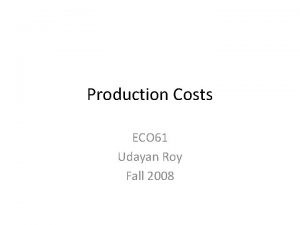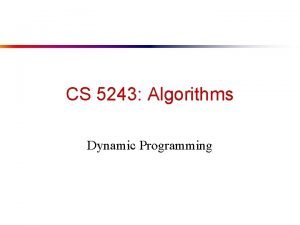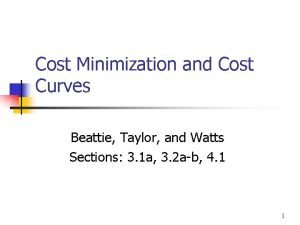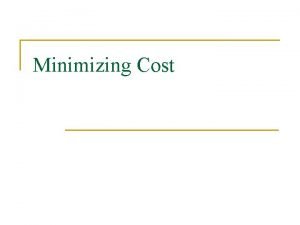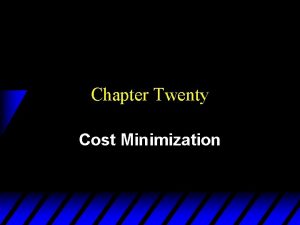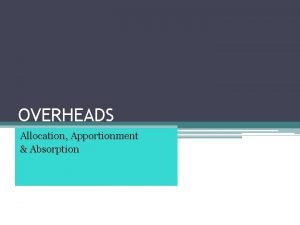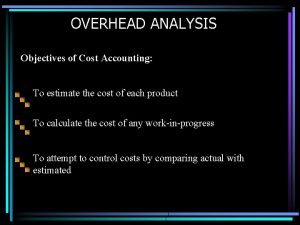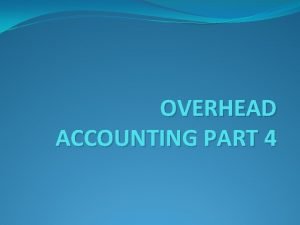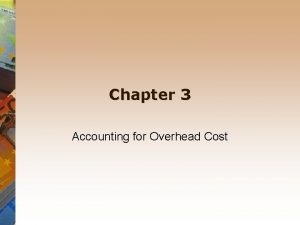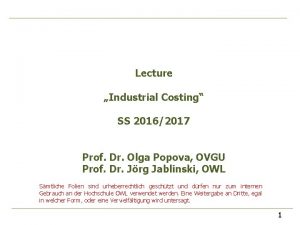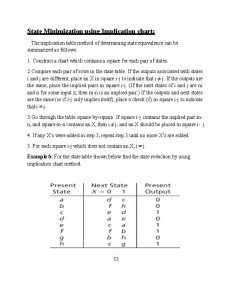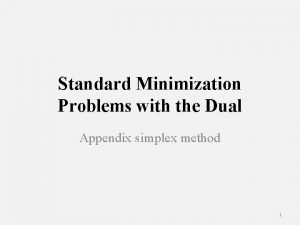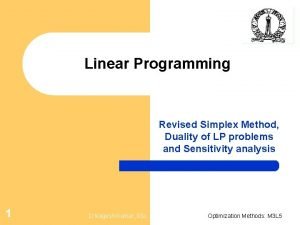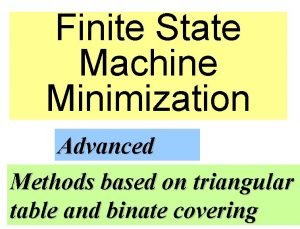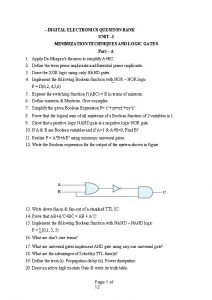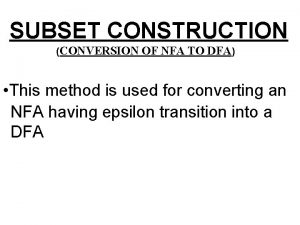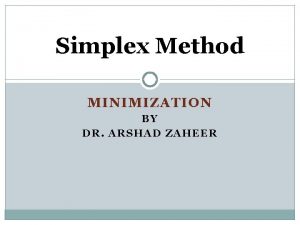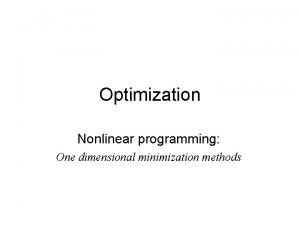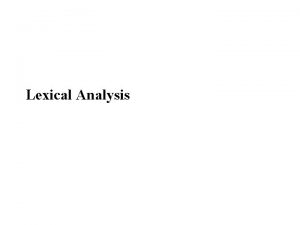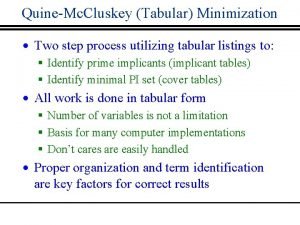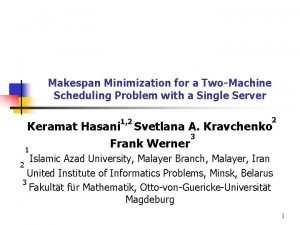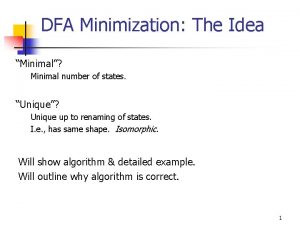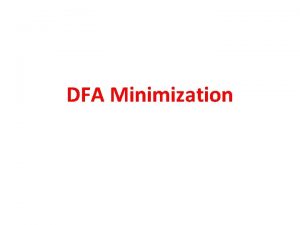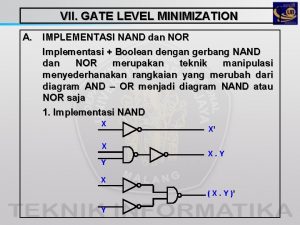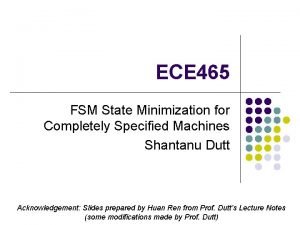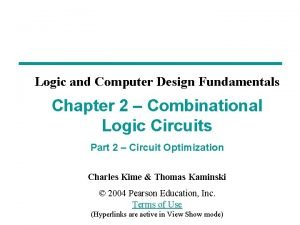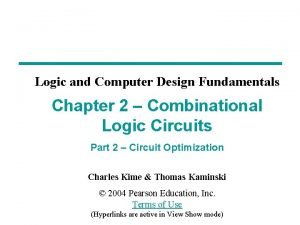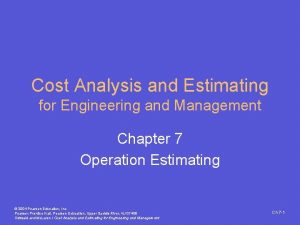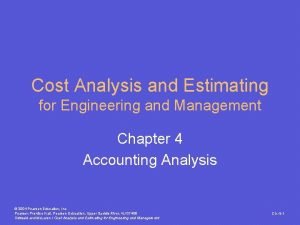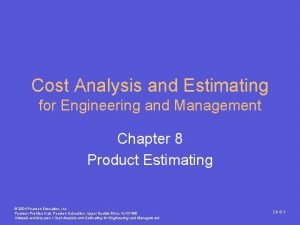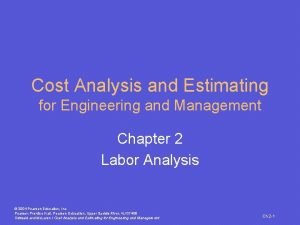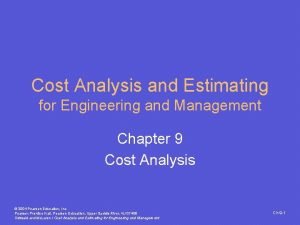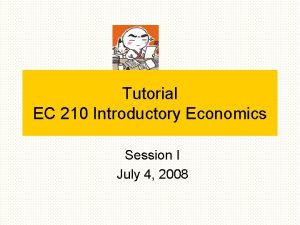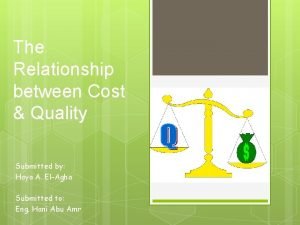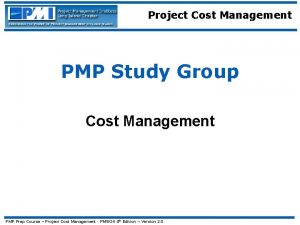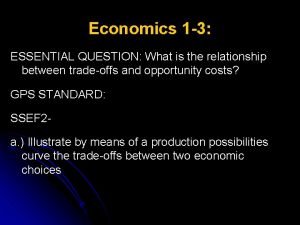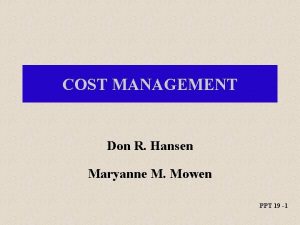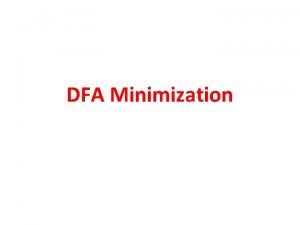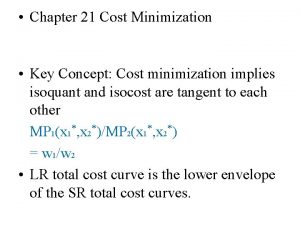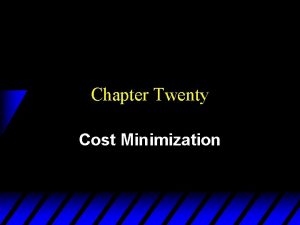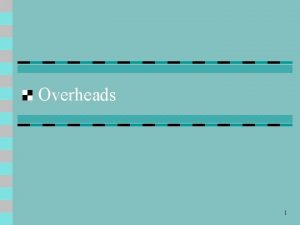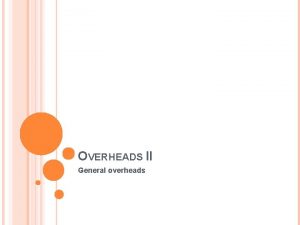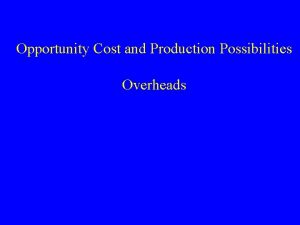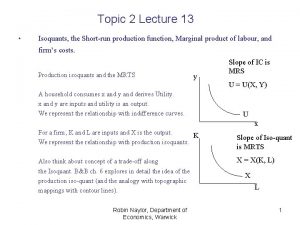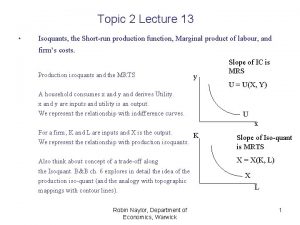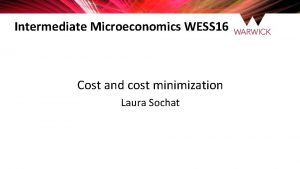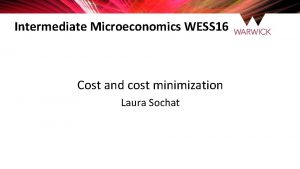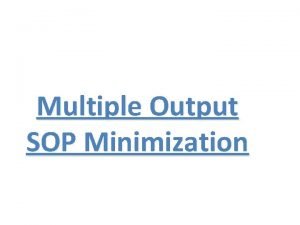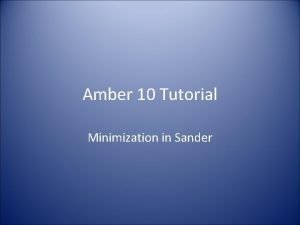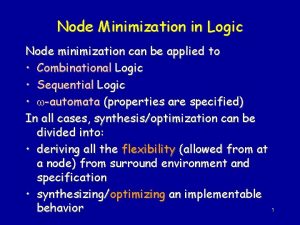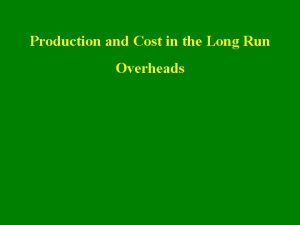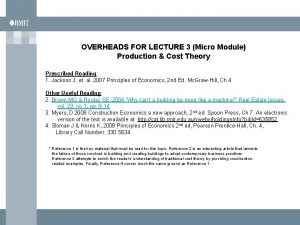Isoquants Isocosts and Cost Minimization Overheads We define











































































- Slides: 75

Isoquants, Isocosts and Cost Minimization Overheads

We define the production function as y represents output f represents the relationship between y and x xj is the quantity used of the jth input (x 1, x 2, x 3, . . . xn) is the input bundle n is the number of inputs used by the firm

Holding other inputs fixed, the production function looks like this Output -y y = f (x 1, x 2, x 3, . . . xn ) 350 300 250 y 200 150 100 50 0 0 2 4 6 8 10 Input -x 12

Marginal physical product is defined as the increment in production that occurs when an additional unit of a particular input is employed

Mathematically we define MPP as

Output -y Graphically marginal product looks like this 60 50 A MPP 40 30 20 10 0 -10 1 2 3 4 5 6 7 8 9 10 -20 -30 -40 Input -x 11

The Cost Minimization Problem Pick y; observe w 1, w 2, etc; choose the least cost x’s

Isoquants An isoquant curve in two dimensions represents all combinations of two inputs that produce the same quantity of output The word “iso”means same while “quant” stand for quantity

Isoquants are contour lines of the production function If we plot in x 1 - x 2 space all combinations of x 1 and x 2 that lead to the same (level) height for the production function, we get contour lines similar to those you see on a contour map Isoquants are analogous to indifference curves Indifference curves represent combinations of goods that yield the same utility Isoquants represent combinations of inputs that yield the same level of production

Production function for the hay example

Another view

Yet another view (low x’s)

With a horizontal plane at y = 250, 000

With a horizontal plane at 100, 000

Contour plot

Another contour plot

There are many ways to produce 2, 000 bales of hay per hour Workers Tractor-Wagons 10 1 6. 45 1. 66 5. 48 2 3. 667 3 2. 636 4 1. 9786 5 Total Cost 80 0. 04 71. 94. 03597 72. 8658 82. 0015 95. 8167 111. 872 AC 0. 0364 0. 041 0. 0479. 0559

Plotting these points in x 1 - x 2 space we obtain

Or Isoquant y = 2, 000 12 X 1 10 8 Isoquant y = 2000 6 4 x 2 = 4, x 1 = 2. 636 2 0 0 2 4 6 8 10 12 X 2 14

Cutting Plane for y = 10, 000

Isoquant for y = 10, 000

Only the negatively sloped portions of the isoquant are efficient

Isoquant for y = 10, 000 x 1 ---12. 469 9. 725 8. 063 6. 883 5. 990 5. 290 x 2 1 2 3 4 5 6 7 8 9 output y 10, 000 10, 000 10, 000

y = 10, 000

y = 2, 000 y = 10, 000

Graphical representation Isoquants y = 2, 000, y = 10, 000 14 x 1 12 10 Isoquant y = 2000 8 Isoquant y = 10000 6 4 2 0 0 2 4 6 8 10 12 14 x 2

y = 2, 000, y = 5, 000, y = 10, 000

More levels

And even more

Comparison to full map

Slope of isoquants An increase in one input (factor) requires a decrease in the other input to keep total production unchanged Therefore, isoquants slope down (have a negative slope)

Properties of Isoquants Higher isoquants represent greater levels of production Isoquants are convex to the origin This means that as we use more and more of an input, its marginal value in terms of the substituting for the other input becomes less and less

Slope of isoquants The slope of an isoquant is called the marginal rate of (technical) substitution [ MR(T)S ] between input 1 and input 2 The MRS tells us the decrease in the quantity of input 1 (x 1) that is needed to accompany a one unit increase in the quantity of input 2 (x 2), in order to keep the production the same

The Marginal Rate of Substitution (MRTS) 14 x 1 12 10 Isoquant y = 2000 8 6 4 Isoquant y = 10000 2 0 0 2 4 6 8 10 12 14 x 2

Algebraic formula for the MRS The marginal rate of (technical) substitution of input 1 for input 2 is We use the symbol - | y = constant - to remind us that the measurement is along a constant production isoquant

Example calculations y = 2, 000 Workers Tractor-Wagons x 1 x 2 10 1 5. 48 2 3. 667 3 2. 636 4 1. 9786 5 Change x 2 from 1 to 2

Example calculations y = 2, 000 Workers Tractor-Wagons x 1 x 2 10 1 5. 48 2 3. 667 3 2. 636 4 1. 9786 5 Change x 2 from 2 to 3

More example calculations y = 10, 000 x 1 12. 469 9. 725 8. 063 6. 883 5. 990 x 2 4 5 6 7 8 Change x 2 from 5 to 6

A declining marginal rate of substitution The marginal rate of substitution becomes larger in absolute value as we have more of an input. The amount of an input we can to give up and keep production the same is greater, when we already have a lot of it. When the firm is using 10 units of x 1, it can give up 4. 52 units with an increase of only 1 unit of input 2, and keep production the same But when the firm is using only 5. 48 units of x 1, it can only give up 1. 813 units with a one unit increase in input 2 and keep production the same

Slope of isoquants and marginal physical product Marginal physical product is defined as the increment in production that occurs when an additional unit of a particular input is employed

Marginal physical product and isoquants All points on an isoquant are associated with the same amount of production Hence the loss in production associated with x 1 must equal the gain in production from x 2 , as we increase the level of x 2 and decrease the level of x 1

Rearrange this expression by subtracting MPPx x 2 2 from both sides, Then divide both sides by MPPx 1 Then divide both sides by x 2

The left hand side of this expression is the marginal rate of substitution of x 1 for x 2, so we can write So the slope of an isoquant is equal to the negative of the ratio of the marginal physical products of the two inputs at a given point

The isoquant becomes flatter as we move to the right, as we use more x 2 (and its MPP declines) and we use less x 1 ( and its MPP increases) So not only is the slope negative, but the isoquant is convex to the origin

The Marginal Rate of Substitution (MRTS) 14 x 1 12 10 Isoquant y = 2000 8 6 4 2 0 0 2 4 6 8 10 12 14 x 2

x 1 Approx MRS x 2 MPP 1 MPP 2 12. 4687 4. 0000 --664. 6851 2585. 7400 11. 8528 4. 1713 -3. 5946 739. 5588 2465. 2134 9. 72555. 0000 -2. 5672 1010. 5290 2050. 0940 9. 34285. 1972 -1. 9411 1063. 1321 1975. 4051 8. 06296. 0000 -1. 5941 1254. 9695 1724. 5840 6. 97926. 9063 -1. 1959 1447. 3307 1508. 9951 6. 88277. 0000 -1. 0291 1466. 3867 1489. 5380

x 1 Approx MRS x 2 MPP 1 MPP 2 12. 4687 4. 0000 --664. 6851 2585. 7400 11. 8528 4. 1713 -3. 5946 739. 5588 2465. 2134 9. 72555. 0000 -2. 5672 1010. 5290 2050. 0940 9. 34285. 1972 -1. 9411 1063. 1321 1975. 4051 8. 06296. 0000 -1. 5941 1254. 9695 1724. 5840 6. 97926. 9063 -1. 1959 1447. 3307 1508. 9951 6. 88277. 0000 -1. 0291 1466. 3867 1489. 5380 x 2 rises and MRS falls

Isocost lines An isocost line identifies which combinations of inputs the firm can afford to buy with a given expenditure or cost (C), at given input prices. Quantities of inputs - x 1, x 2, x 3, . . . Prices of inputs - w 1, w 2, w 3, . . .

Graphical representation Cost = 120 w 1 = 6 w 2 = 20 22 x 1 20 18 16 14 12 10 8 6 4 2 0 0 1 2 3 4 5 6 x 2 7

Slope of the isocost line So the slope is -w 2 / w 1

Example C = $120, w 1 = 6. 00, w 2 = 20. 00

Intercept of the isocost line So the intercept is C / w 1 With higher cost, the isocost line moves out

Isoquants and isocost lines We can combine isoquants and isocost lines to help us determine the least cost input combination The idea is to be on the lowest isocost line that allows production on a given isoquant

Combine an isoquant with several isocost lines Isocost lines for $20, $60, $120, $180, $240, $360

Consider C = 120 and C = 180 Isoquant y = 10000 24 X 1 20 Isocost 120 16 Isocost 180 12 8 4 0 3 4 5 6 7 8 9 10 11 12 13 X 2 At intersection there are opportunities for trade

Add C = 160 24 Isoquant y = 10000 X 1 20 Isocost 120 16 Isocost 180 Isocost 160 12 8 4 0 4 5 6 7 8 9 10 11 12 13 X 2

Add C = 154. 6 24 Isoquant y = 10000 X 1 20 Isocost 120 16 Isocost 180 Isocost 160 12 Isocost 154. 6 8 4 0 4 5 6 7 8 9 10 11 12 13 X 2

In review 24 Isoquant y = 10000 X 1 20 Isocost 120 16 Isocost 180 Isocost 160 12 Isocost 154. 6 8 4 0 4 5 6 7 8 9 10 11 12 13 X 2

The least combination of inputs The optimal input combination occurs where the isoquant and the isocost line are tangent Tangency implies that the slopes are equal

Slope of the isocost line -w 2 / w 1 Slope of the isoquant

Optimality conditions Slope of the isocost line = Slope of the isoquant Substituting we obtain The price ratio equals the ratio of marginal products

We can write this in a more interesting form Multiply both sides by MPPx 1 and then divide by w 2

Graphical representation

Statement of optimality conditions a. The optimum point is on the isocost line b. The optimum point is on the isoquant c. The isoquant and the isocost line are tangent at the optimum combination of x 1 and x 2

d. The slope of the isocost line and the slope of the isoquant are equal at the optimum e. The ratio of prices is equal to the ratio of marginal products

f. The marginal product of each input divided by its price is equal to the marginal product of every other input divided by its price

Example Table w 1 = 6, w 2 = 20 To get an x 1, I can give up 3. 33 x 2 in terms of cost x 1 x 2 Approx MRS MPP 1 1. 0000 2. 0000 3. 0000 12. 4687 4. 0000 11. 8528 4. 1713 -3. 5946 9. 7255 5. 0000 -2. 5672 9. 3428 5. 1972 -1. 9411 8. 0629 6. 0000 -1. 5941 6. 9792 6. 9063 -1. 1959 6. 8827 7. 0000 -1. 0291 5. 9898 8. 0000 -0. 8929 5. 2904 9. 0000 -0. 6994 4. 7309 10. 0000 -0. 5595 4. 2773 11. 0000 -0. 4535 3. 9071 12. 0000 -0. 3702 3. 6042 13. 0000 -0. 3029 664. 6851 739. 5588 1010. 5290 1063. 1321 1254. 9695 1447. 3307 1466. 3867 1663. 9176 1855. 3017 2044. 1823 2232. 4134 2420. 9761 2610. 3937 MPP 2 MPP 1/w 1 2585. 7400 2465. 2134 2050. 0940 1975. 4051 1724. 5840 1508. 9951 1489. 5380 1305. 9560 1155. 0760 1026. 1700 912. 4680 809. 4240 713. 8360 110. 7809 123. 2598 168. 4215 177. 1887 209. 1616 241. 2218 244. 3978 277. 3196 309. 2169 340. 6971 372. 0689 403. 4960 435. 0656 MPP 2/w 2 MRS -w 2 / w 1 129. 2870 123. 2607 102. 5047 98. 7703 86. 2292 75. 4498 74. 4769 65. 2978 57. 7538 51. 3085 45. 6234 40. 4712 35. 6918 -3. 3333 -3. 8902 -3. 3334 -2. 0287 -1. 8581 -1. 3742 -1. 0426 -1. 0158 -0. 7849 -0. 6226 -0. 5020 -0. 4087 -0. 3343 -0. 2735

Intuition for the conditions The isocost line tells us the rate at which the firm is able to trade one input for the other, given their relative prices and total expenditure For example in this case the firm must give up 3 1/3 units of input 1 in order to buy a unit of input 2

w 1 = 6 w 2 = 20 C = 180 24 X 1 20 16 6. 66 Isocost 180 12 10 8 4 0 3 4 5 6 7 8 9 10 11 12 13 X 2

The isoquant tells us the rate at which the firm can trade one input for the other and remain at the same production level 24 Isoquant y = 10000 x 1 20 16 12 8 4 0 4 5 6 7 8 9 10 11 12 13 x 2

If there is any difference between the rate at which the firm can trade one input for another with no change in production and the rate at which it is able to trade given relative prices, the firm can always make itself better off by moving up or down the isocost line

The isoquant tells us the rate at which the firm can trade one input for the other and remain at the same production level 24 Isoquant y = 10000 x 1 20 16 Isocost 180 Isocost 160 12 8 4 0 4 5 6 7 8 9 10 11 12 13 x 2

When the slope of the isoquant is steeper than the isocost line, the firm will move down the line When the slope of the isoquant is less steep than the isocost line, the firm will move up the line

When the slope of the isoquant is steeper than the isocost line, the firm will move down the line 24 Isoquant y = 10000 x 1 20 16 12 8 4 0 4 5 6 7 8 9 10 11 12 13 x 2

The End
 Cost minimizing rule
Cost minimizing rule Cost minimization formula
Cost minimization formula Cost minimization
Cost minimization Short run cost minimization
Short run cost minimization Cost minimization analysis
Cost minimization analysis Cost minimization perfect complements
Cost minimization perfect complements Objectives of overhead apportionment and absorption
Objectives of overhead apportionment and absorption Overhead analysis
Overhead analysis Over absorbed overheads
Over absorbed overheads Overhead cost per unit
Overhead cost per unit Primary distribution of overheads
Primary distribution of overheads Classification of overhead
Classification of overhead Mapa de karnaugh 4 variables
Mapa de karnaugh 4 variables Implications table
Implications table Standard minimization problem
Standard minimization problem Expected risk machine learning
Expected risk machine learning Dual simplex method example maximization
Dual simplex method example maximization Finite state machine minimization
Finite state machine minimization Digital electronics question bank
Digital electronics question bank Dfa minimization code in c++
Dfa minimization code in c++ Big m method minimization with mixed constraints
Big m method minimization with mixed constraints Subset construction method
Subset construction method Big m method minimization
Big m method minimization Interval halving method optimization example
Interval halving method optimization example Dfa for (a/b)*abb
Dfa for (a/b)*abb Tabular method of minimization
Tabular method of minimization Makespan minimization
Makespan minimization Cp meaning psychology
Cp meaning psychology Dfa minimization examples
Dfa minimization examples Dominos recall
Dominos recall Gate level minimization
Gate level minimization Empirical risk minimization python
Empirical risk minimization python Bddgaf
Bddgaf Risk minimization plan
Risk minimization plan Cost accumulation and cost assignment
Cost accumulation and cost assignment Cost accumulation and cost assignment
Cost accumulation and cost assignment Cost accumulation and cost assignment
Cost accumulation and cost assignment What is a period cost on the income statement
What is a period cost on the income statement Dennis geyer
Dennis geyer Characteristics of standard costing
Characteristics of standard costing Distinguish between average cost and marginal cost
Distinguish between average cost and marginal cost Cost control and cost reduction difference
Cost control and cost reduction difference Job order cost system
Job order cost system Ordering cost and carrying cost
Ordering cost and carrying cost Actual cost and opportunity cost
Actual cost and opportunity cost Cost control and cost reduction project report
Cost control and cost reduction project report Cost control and cost reduction project report
Cost control and cost reduction project report The relative proportion of variable fixed or mixed
The relative proportion of variable fixed or mixed Manufacturing cost vs non manufacturing cost
Manufacturing cost vs non manufacturing cost Process vs job costing
Process vs job costing Floatation cost
Floatation cost Non controllable cost
Non controllable cost Manufacturing cost vs non manufacturing cost
Manufacturing cost vs non manufacturing cost Voh cost
Voh cost Opportunity cost of equity capital
Opportunity cost of equity capital Literal cost gate input cost
Literal cost gate input cost Literal cost gate input cost
Literal cost gate input cost Literal cost gate input cost
Literal cost gate input cost Define cost segregation
Define cost segregation Cost analysis and estimating for engineering and management
Cost analysis and estimating for engineering and management Cost analysis and estimating for engineering and management
Cost analysis and estimating for engineering and management Cost analysis and estimating for engineering and management
Cost analysis and estimating for engineering and management Cost analysis and estimating for engineering and management
Cost analysis and estimating for engineering and management Cost analysis and estimating for engineering and management
Cost analysis and estimating for engineering and management Trade off and opportunity cost
Trade off and opportunity cost Relationship between quality and cost
Relationship between quality and cost Porter's competitive strategies
Porter's competitive strategies Resource and cost planning
Resource and cost planning Cost management tools and techniques
Cost management tools and techniques Menus recipes and cost management
Menus recipes and cost management Multinational capital structure
Multinational capital structure Trade off and opportunity cost
Trade off and opportunity cost Difference between direct and indirect cost
Difference between direct and indirect cost Food and beverage cost control 5th edition pdf
Food and beverage cost control 5th edition pdf Opportunity costs and trade offs
Opportunity costs and trade offs Cost management hansen
Cost management hansen
